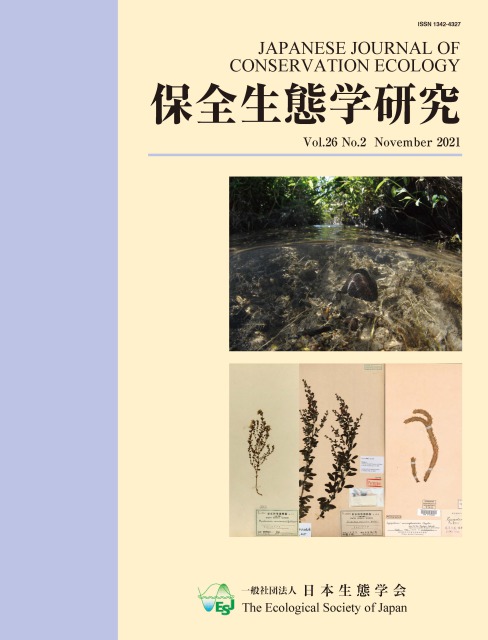Volume 26, Issue 2
Displaying 1-18 of 18 articles from this issue
- |<
- <
- 1
- >
- >|
-
2021Volume 26Issue 2 Article ID: hozen.26.2_Cover1
Published: 2021
Released on J-STAGE: December 31, 2021
Download PDF (2576K) -
2021Volume 26Issue 2 Pages Toc1-
Published: 2021
Released on J-STAGE: December 31, 2021
Download PDF (779K)
Original Article
-
Article type: Original Article
2021Volume 26Issue 2 Article ID: 2040
Published: August 31, 2021
Released on J-STAGE: December 31, 2021
Advance online publication: August 31, 2021Download PDF (2017K) -
Article type: Original Article
2021Volume 26Issue 2 Article ID: 2039
Published: August 31, 2021
Released on J-STAGE: December 31, 2021
Advance online publication: August 31, 2021Download PDF (8485K) -
Article type: Original Article
2021Volume 26Issue 2 Article ID: 2041
Published: August 31, 2021
Released on J-STAGE: December 31, 2021
Advance online publication: August 31, 2021Download PDF (3105K) -
Article type: Original Article
2021Volume 26Issue 2 Article ID: 2038
Published: August 31, 2021
Released on J-STAGE: December 31, 2021
Advance online publication: August 31, 2021Download PDF (2243K) -
Article type: Original Article
2021Volume 26Issue 2 Article ID: 2109
Published: October 31, 2021
Released on J-STAGE: December 31, 2021
Advance online publication: October 31, 2021Download PDF (4700K)
Review
-
Article type: Review
2021Volume 26Issue 2 Article ID: 2110
Published: October 31, 2021
Released on J-STAGE: December 31, 2021
Advance online publication: October 31, 2021Download PDF (1404K)
Report
-
Article type: Report
2021Volume 26Issue 2 Article ID: 2029
Published: August 31, 2021
Released on J-STAGE: December 31, 2021
Advance online publication: August 31, 2021Download PDF (1508K) -
Article type: Report
2021Volume 26Issue 2 Article ID: 2044
Published: October 31, 2021
Released on J-STAGE: December 31, 2021
Advance online publication: October 31, 2021Download PDF (1133K) -
Article type: Report
2021Volume 26Issue 2 Article ID: 2024
Published: August 31, 2021
Released on J-STAGE: December 31, 2021
Advance online publication: August 31, 2021Download PDF (3078K) -
Article type: Report
2021Volume 26Issue 2 Article ID: 2027
Published: August 31, 2021
Released on J-STAGE: December 31, 2021
Advance online publication: August 31, 2021Download PDF (3154K) -
Article type: Report
2021Volume 26Issue 2 Article ID: 2111
Published: October 31, 2021
Released on J-STAGE: December 31, 2021
Advance online publication: October 31, 2021Download PDF (3221K) -
Article type: Report
2021Volume 26Issue 2 Article ID: 2042
Published: October 31, 2021
Released on J-STAGE: December 31, 2021
Advance online publication: October 31, 2021Download PDF (7266K)
Practice Report
-
Article type: Practice Report
2021Volume 26Issue 2 Article ID: 2104
Published: October 31, 2021
Released on J-STAGE: December 31, 2021
Advance online publication: October 31, 2021Download PDF (4020K)
Scientific Proposal
-
Article type: Scientific Proposal
2021Volume 26Issue 2 Article ID: 2105
Published: October 31, 2021
Released on J-STAGE: December 31, 2021
Advance online publication: October 31, 2021Download PDF (1191K)
-
2021Volume 26Issue 2 Pages App1-
Published: 2021
Released on J-STAGE: December 31, 2021
Download PDF (300K) -
2021Volume 26Issue 2 Article ID: hozen.26.2_Toc2
Published: 2021
Released on J-STAGE: December 31, 2021
Download PDF (2635K)
- |<
- <
- 1
- >
- >|
